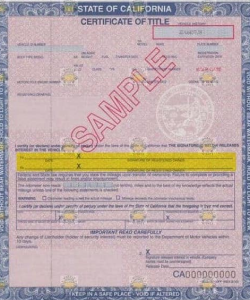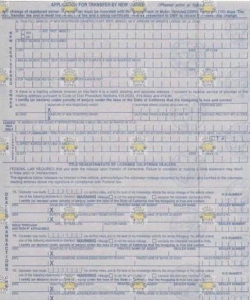Transferring a Title and Registration

Overview
- What Is a Vehicle Title
- Types of Vehicle Titles
- How To Transfer a Vehicle Title
- What Is a Vehicle Registration
- How To Register A Vehicle
- Helpful Links
While CarXstream makes the buying and selling process much easier, we are unable to transfer your new vehicle’s Title and Registration, that must be completed by you and the seller at your local BMV Branch.
What is a Vehicle Title?


A vehicle title is an official document that establishes ownership of a specific vehicle. It serves as legal proof that a person or entity is the rightful owner of the vehicle. The title contains important information about the vehicle, such as the vehicle identification number (VIN), make, model, year of manufacture, and the current owner's name and address. When a vehicle is purchased or transferred from one person to another, the title is used to document the change of ownership. The title is typically issued by a government agency, such as the Department of Motor Vehicles (DMV) in the United States, and it must be obtained and transferred during the process of buying or selling a vehicle.
The vehicle title is an essential document for various purposes, including registering the vehicle with the appropriate authorities, obtaining license plates, and proving ownership in case of disputes or legal issues. It is important to keep the vehicle title in a safe place, as losing or damaging it may complicate future transactions involving the vehicle.
Types of Vehicle Titles
In the United States, there are several types of vehicle titles that may vary depending on the state. Here are some common types:
A clean title indicates that there are no significant issues or liens on the vehicle. It means the vehicle has not been salvaged, stolen, or involved in major accidents.
Salvage Title:A salvage title is given to a vehicle that has been significantly damaged, usually due to an accident, flood, fire, or theft. Salvage titles are issued to vehicles that are considered a total loss by insurance companies. These vehicles are typically repaired and can be put back on the road, but they may have a lower market value and could have hidden issues.
Rebuilt Title:A rebuilt title is given to a salvage vehicle that has been repaired and restored to a roadworthy condition. Once the vehicle passes an inspection by the appropriate authorities, it can be issued a rebuilt title, indicating that it has undergone repairs and is fit for use.
Lemon Title:A lemon title is given to a vehicle that has a history of significant defects or mechanical issues. Lemon laws vary by state, but generally, if a vehicle has undergone multiple failed attempts to repair the same problem within a certain timeframe, it may be deemed a "lemon."
Bonded Title:A bonded title is issued when there is a lack of proper documentation or proof of ownership for a vehicle. To obtain a bonded title, the owner must provide a surety bond as a form of financial guarantee, which protects any potential claims against the vehicle's ownership. Duplicate Title: A duplicate title is issued when the original title has been lost, stolen, or damaged. It serves as a replacement for the original title and carries the same information and legal status.
These are some common types of vehicle titles in the United States. However, it's important to note that the specific terminology and requirements may differ between states or countries. It's always advisable to consult your local DMV or equivalent agency for accurate and up-to-date information regarding vehicle titles in your area.
How To Transfer a Vehicle Title
To transfer a vehicle title, follow these general steps:
You will typically need the current vehicle title, a bill of sale (if applicable), a completed application for title transfer, and any other required documents specified by your local DMV or equivalent agency.
Research State-Specific Requirements:Check your state's DMV website or contact the agency directly to learn about specific requirements and procedures for transferring a vehicle title. Each state may have different rules and forms.
Fill Out the Title Transfer Form:Complete the application or form for title transfer accurately and legibly. Provide all the required information, such as the buyer's and seller's details, vehicle information (VIN, make, model, year), odometer reading, and sale price.
Pay Any Required Fees:In most cases, you will need to pay a fee to transfer the title. The fee amount can vary depending on your location and other factors. Check with your local DMV for the specific fee and payment methods accepted.
Submit the Documents:Take the completed title transfer form, current title, bill of sale, and any other required documents to the appropriate DMV office or agency. Some states may also allow you to submit the paperwork online or through mail.
Provide Proof of Insurance:In many states, you may need to provide proof of insurance coverage for the vehicle before the title transfer is processed. Check your state's requirements and have the necessary insurance documentation ready.
Complete the Process:Once you have submitted the required documents and paid the necessary fees, the DMV will process your title transfer request. If approved, you will receive a new title in the buyer's name.
Remember, these steps are general guidelines, and the specific requirements and procedures can vary by state or country. It is advisable to consult your local DMV or equivalent agency for detailed instructions tailored to your location.
What is a Vehicle Registration?
.png)
Vehicle registration is a process that involves officially recording a vehicle with the appropriate government agency or department responsible for motor vehicles. It is a legal requirement in most jurisdictions and serves several purposes. When you register a vehicle, you typically provide information about the vehicle and its owner to the registration authority. This information may include the vehicle identification number (VIN), make, model, year of manufacture, current odometer reading, and the owner's name and address. The registration authority then issues a unique registration number or license plate for the vehicle. The specific process and requirements for vehicle registration can vary between countries, states, or regions. It typically involves filling out registration forms, providing necessary documents (such as proof of ownership, identification, and insurance), paying applicable fees, and obtaining registration plates or stickers for the vehicle. It's important to consult your local government agency responsible for vehicle registration to understand the specific procedures and requirements in your area.
How To Register a Vehicle
To register your vehicle, the specific steps and requirements can vary depending on your country, state, or region. However, I can provide you with a general outline of the process. It's important to consult your local government agency responsible for vehicle registration to understand the specific procedures and requirements in your area. Here are the general steps involved in registering a vehicle:
Prepare the necessary documents, which may include the vehicle title or proof of ownership, identification documents (such as a valid driver's license or passport), proof of insurance, emissions or safety inspection certificate (if required), and any other documents specified by your local registration authority.
Complete Registration Application:Obtain the appropriate registration application form from your local vehicle registration office or website. Fill out the form accurately and provide all the required information, including your personal details, vehicle information (make, model, year, VIN), and any additional information requested.
Provide Proof of Insurance:In many jurisdictions, proof of insurance coverage is a requirement for vehicle registration. Provide the necessary documentation, such as an insurance policy or insurance card, to demonstrate that your vehicle is insured as per the local regulations.
Pay Registration Fees:Calculate the registration fees based on your vehicle type, weight, and location. Check with your local registration authority to determine the exact amount and acceptable payment methods. Fees may include vehicle registration fees, taxes, and any additional charges.
Submit the Application and Fees:Visit your local vehicle registration office in person, or submit the completed application form, required documents, and payment to the designated office or online portal. Ensure that all information and documents are provided accurately and in compliance with the registration requirements.
Receive Registration Documents:Once your application is processed and approved, you will receive your registration documents. These may include a registration certificate, license plates or registration stickers, and any other relevant documents.
Affix License Plates and Display Registration Stickers:Install the license plates on your vehicle as per the instructions provided. If required, affix the registration stickers to your license plates or windshield as specified by your local regulations.
It's important to note that these steps are general guidelines, and the specific requirements and procedures can vary by jurisdiction. Always consult your local vehicle registration authority or Department of Motor Vehicles (DMV) for accurate and up-to-date information regarding vehicle registration in your area.


